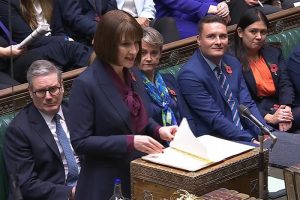How will the US election affect markets?
Resilient US economic data and the close race between Republican candidate Donald Trump and Democratic nominee Kamala Harris for the presidency have left investors preparing for sharp swings in markets next week.
Yields on 10-year Treasuries have risen 0.6 percentage points since October 1. An ICE BofA gauge of implied Treasury market volatility lurched higher last month while the dollar posted its biggest monthly gain since 2022.
The rapidly changing sentiment has been driven in part by a spate of strong economic data, which has called into question how rapidly and deeply the Federal Reserve needs to cut interest rates.
However, many market participants also believe that higher yields and a rising dollar stem from increasing expectations of a Trump victory in Tuesday’s election — a scenario widely perceived to be inflationary, not least because of his economic policy of trade tariffs.
“The election results are too close to call, and the magnitude of the move [in Treasuries] will be determined by where yields sit Tuesday morning,” said Leslie Falconio, a strategist at UBS Global Wealth Management.
“A Harris response is more fundamentally driven while Trump more politically driven, which could move the 10-year yields around plus or minus 0.3 percentage points, depending on the starting level.”
A Trump victory could, investors say, deter the Federal Reserve from making further big rate cuts after its jumbo-sized 0.5 percentage point reduction in September.
The Fed will announce its next rate decision next Thursday and much weaker-than-expected payrolls report on Friday — distorted by hurricanes and worker strikes — has cemented predictions in markets of a quarter-point cut.
Laura Castleton, US head of portfolio construction and strategy at Janus Henderson Investors, said the jobs report was unlikely to influence either the election or the Fed. It “will probably be 25-basis-points cut amid this backdrop”, she said. Harriet Clarfelt
Will the Bank of England signal fewer rate cuts?
Investors will be following Thursday’s Bank of England meeting for further clues on the pace of UK rate cuts, after this week’s Labour Budget signalled the government would significantly scale up borrowing.
Markets still expect a quarter percentage point cut from the BoE, to 4.75 per cent, but the probability of that happening has decreased from near certainty to 80 per cent. Swaps markets are also pricing in four rate cuts by the end of next year, instead of the five priced in before the Budget announcement.
Analysts say the shift in sentiment is because the expected borrowing, about £28bn extra a year, and spending is expected to boost short-term economic growth and inflation.
“This loosening in fiscal policy supports our view that the Bank of England will not step up the pace of monetary loosening — but it should not stop a 0.25 percentage point rate cut at this week’s November meeting,” said George Buckley, an economist at Nomura.
A month ago Andrew Bailey, the Bank of England governor, opened the door to a faster pace of interest rate cuts saying the central bank could become “a bit more activist” in its approach.
Analysts at Deutsche Bank said his comments were based on inflation slowing faster than the BoE’s prediction in August. Inflation dropped to 1.7 per cent in September, falling below the central bank’s target of 2 per cent for the first time in three years.
“But the recent fiscal news will probably throw a wrench in the [Bank’s] confidence levels that excess demand pressures are receding,” said Sanjay Raja, an economist at Deutsche.
The Budget announcements “reinforce the case for a gradual interest rate easing path, rather than a more ‘activist’ one,” said Dani Stoilova, Europe economist at BNP Paribas. Valentina Romei
Will the China services sector show signs of growth?
China’s factory activity unexpectedly expanded for the first time in six months in October, in a boost to Beijing’s policymakers as they prepare to launch a fiscal stimulus to shore up the world’s second-largest economy.
The Caixin services purchasing managers’ index on Tuesday will reveal whether the country’s services sector has also begun to reverse its fortunes.
In September the services sector recorded its slowest pace of expansion since October 2023, at 50.3. A reading above 50 marks growth.
But economists expect the pace to have increased slightly last month, with a poll by Bloomberg suggesting a reading of 50.5 for October.
“We expect Caixin service PMI to have picked up a tad in October, in tandem with the rebound in manufacturing PMI,” said Jacqueline Rong, chief China economist at BNP Paribas.
“The drivers of this mild uptick included a rebound in property sales related services after recent policy easing, services catering to manufacturing activities and an acceleration in public services as the government has stepped up spending since September.”
The figures will be released during a meeting of the standing committee of China’s rubber-stamp parliament, the National People’s Congress.
It is expected to confirm the size of its fiscal stimulus, aimed at boosting flagging economic growth, in the days after the US presidential election on November 5. Arjun Neil Alim
#election #affect #markets





